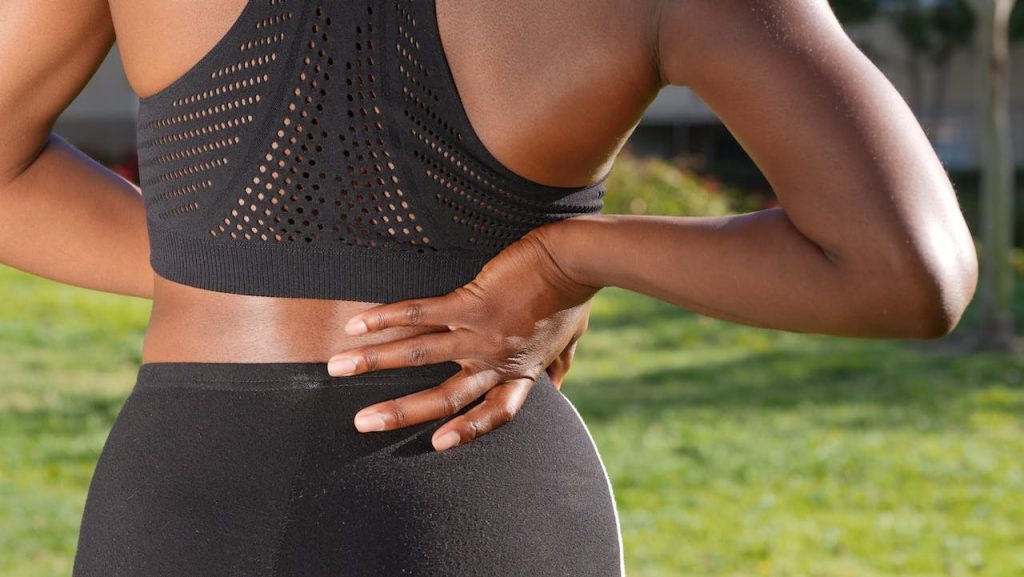Geschatte leestijd: 3 minutenNew research from Ohio State University aims to explain the cause of lower back pain in runners and suggests preventive exercises.
Running and Lower Back Pain
Quite annoying; You’re running and could keep going for half an hour or longer in terms of fitness. Then, however, that nagging pain starts from the lower back. Maintaining an upright posture can prove to be a bigger challenge at that moment than running itself.
Lower back pain can arise for various reasons. In the general population, not specifically runners, this is determined by strained muscles and tendons and bruises of soft tissue in 97% of cases [3].
In recent research from Ohio State University, the researchers came to two conclusions [1]:
- Pain in the lower back during running is caused by weak deep core muscles.
- In most people, these muscles are nowhere near as strong as they should be.
Muscle Activity During Running
To study the role distribution between the deeper and superficial muscles, the researchers used motion sensors and pressure plates in the floor. With this, the Ohio State team observed the movement of eight healthy young adults.
We measured the dimensions of runners’ bodies and how they moved to create a computer model that’s specific to that person. That allows us to examine how every bone moves and how much pressure is put on each joint. We can then use that simulation to virtually ‘turn off’ certain muscles and observe how the rest of the body compensates.
Ajit Chaudhari, associate professor of physical therapy and biomedical engineering, The Ohio State University Wexner Medical Center
They found that weak deep core muscles force the superficial muscles like the abs to work harder, causing them to fatigue earlier. Taking over the tasks that should actually be performed by the deeper muscles can have painful consequences. Although your body can compensate well for those weaker muscles to make the same movements, according to Chaudhari and colleagues, this increases the pressure on the spine. This can then lead to the well-known lower back pain.
Deeper Core Muscles
When it comes to deeper muscles, think of:
- Multifidus: Very short muscles that run from the side of a vertebra to the middle and back of the vertebra. Their main function is to provide stability. They have a small range of motion that provides continuous, small, stabilizing movements throughout the day.
- Transversus Abdominis: The deepest lying flat abdominal muscle. The ‘corset muscle’ of the spine and pelvis. Earns this title due to the inward pulling action of the abdominal muscles in front of it. Tries to protect the spine, tendons, vertebrae, and nerves by contracting anticipatorily in response to movement.
- Quadratus lumborum: Located in line with the transversus abdominis, equally deep but more internally located. Due to its deep location, it is often seen as a back muscle. The quadratus lumborum is a common source of back pain. When the lower fibers of the erector spinae do not adequately perform their function, the quadratus lumborum takes over. This is often the case when people perform a lot of sitting work [2].
However, there are more deep core muscles, and in some cases, part of the muscle is superficial while another part is deep. This applies, for example, to the psoas major.
Situps and Back Extensions Not Effective (Enough)
Not only untrained individuals would underestimate the importance of these core muscles. Many well-trained athletes would also give them too little attention, partly due to incorrect information online and in fitness magazines. Specifically, they mention popular exercises such as sit-ups and back extensions, which according to the team, are both insufficiently capable of activating the deeper lying muscles you need as a runner.
Instead, you should focus more on stabilizing exercises, such as plank exercises. Especially execution on unstable surfaces could prevent many complaints. It may not look great when you’re sitting on a stability ball at your desk, but it’s not completely crazy either.
Working on a six-pack and trying to become a better runner is definitely not the same thing. If you look at great runners, they don’t typically have a six-pack but their muscles are very fit. Static exercises that force you to fire your core and hold your body in place are what’s really going to make you a better runner.
References
- Margaret E. Raabe, Ajit M.W. Chaudhari. Biomechanical consequences of running with deep core muscle weakness. Journal of Biomechanics, 2017; DOI: 10.1016/j.jbiomech.2017.11.037
- Core Topics in Pain, p. 131, Anita Holdcraft and Sian Jaggar, 2005.
- An HS, Jenis LG, Vaccaro AR. Adult spine trauma. In: Beaty JH, editor. , ed. Orthopaedic Knowledge Update 6. Rosemont, IL: American Academy of Orthopaedic Surgeons; 1999:653-671

